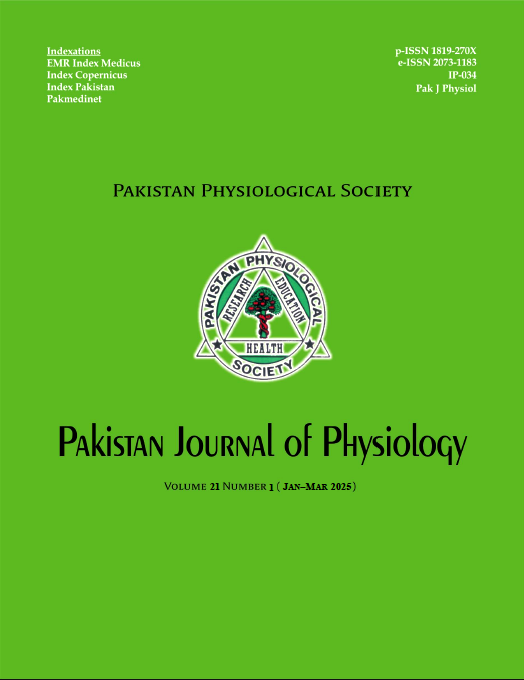A HETEROZYGOUS BCL11B GENE VARIANT INDUCES SCID AND HYPO-IMMUNOGLOBULINEMIA IN A PAKISTANI FAMILY
DOI:
https://doi.org/10.69656/pjp.v21i1.1821Keywords:
DNA Sanger sequencing, BCL11b gene, Hypo-immunoglobulinemia,, Complete Blood Count, CBCAbstract
Background: The gene B-cell lymphoma/leukaemia 11B (BCL11B) which encodes the zinc finger transcription factor plays a crucial role in the development of the central nervous system and T cell differentiation by regulating the expression of numerous genes in early development. BCL11B gene defects lead to neurological and immunologic disease manifestations. Methods: In this study, we enrolled a 2-month-old male patient from a highly consanguine Pakistani family segregating autosomal dominant type of Primary Atopic Disorders (PADs) along with low immunoglobulin levels. Detailed clinical evaluations were performed by expert paediatrician. Whole blood samples were collected in EDTA tubes for genetic analysis. Detailed laboratory tests including complete blood count, and serum immunoglobulin levels, were performed. Results: Genetic analysis revealed four mutations in different genes. A heterozygous missense mutation [(c.2035C>T; p.Pro679Ser), ENST00000357195.8] in the gene BCL11B gene was found segregating (parents and healthy siblings were homozygous normal while patient was heterozygous) in the family. Flow cytometery and serum immunoglobulin estimation revealed Elevated Total Leukocyte Counts (TLC) and low serum immunoglobulins. Conclusion: The current study describes a novel heterozygous missense mutation in gene BCL11B. Clinical investigations revealed novel findings with novel clinical manifestations including short-term neurological seizures and recurrent pneumonia.
Pak J Physiol 2025;21(1):52–5, DOI: https://doi.org/10.69656/pjp.v21i1.1821
Downloads
References
Milner JD. Primary atopic disorders. Annu Rev Immunol 2020;38(1):785–808.
Lennon MJ, Jones SP, Lovelace MD, Guillemin GJ, Brew BJ. Bcl11b: a new piece to the complex puzzle of amyotrophic lateral sclerosis neuropathogenesis? Neurotox Res 2016;29(2):201–7.
Sidwell T, Rothenberg EV. Epigenetic dynamics in the function of T-lineage regulatory factor Bcl11b. Front Immunol 2021;12:669498.
Cismasiu VB, Ghanta S, Duque J, Albu DI, Chen HM, Kasturi R, Avram D. BCL11B participates in the activation of IL2 gene expression in CD4+ T lymphocytes. Blood 2006;108(8):2695–702.
Simon R, Brylka H, Schwegler H, Venkataramanappa S, Andratschke J, Wiegreffe C, et al. A dual function of Bcl11b/Ctip2 in hippocampal neurogenesis. EMBO J 2012;31(13):2922–36.
Daher MT, Bausero P, Agbulut O, Li Z, Parlakian A. Bcl11b/Ctip2 in skin, tooth, and craniofacial system. Front Cell Dev Biol 2020;8:581674.
Kojo S, Tanaka H, Endo TA, Muroi S, Liu Y, Seo W, et al. Priming of lineage-specifying genes by Bcl11b is required for lineage choice in post-selection thymocytes. Nat Commun 2017;8(1):702.
García-Aznar JM, Alonso Alvarez S, Bernal del Castillo T. Pivotal role of BCL11B in the immune, hematopoietic and nervous systems: a review of the BCL11B-associated phenotypes from the genetic perspective. Genes Immun 2024;25(3)232–41.
Yu Y, Wang C, Clare S, Wang J, Lee SC, Brandt C, et al. The transcription factor Bcl11b is specifically expressed in group 2 innate lymphoid cells and is essential for their development. J Exp Med 2015;212(6):865–74.
Yan S, Wei YS, Yang QY, Yang L, Zeng T, Tang XM, et al. A case report of BCL11B mutation induced neurodevelopmental disorder and literature review. Zhonghua Er Ke Za Zhi 2020;58(3):223–7.
Lessel D, Gehbauer C, Bramswig NC, Schluth-Bolard C, Venkataramanappa S, Van Gassen KL, et al. BCL11B mutations in patients affected by a neurodevelopmental disorder with reduced type 2 innate lymphoid cells. Brain 2018;141(8):2299–311.
Che F, Tie X, Lei H, Zhang X, Duan M, Zhang L, et al. Identification of two novel variants of the BCL11B gene in two Chinese pedigrees associated with neurodevelopmental disorders. Front Mol Neurosci 2022;15:927357.
Downloads
Published
How to Cite
Issue
Section
License
Copyright (c) 2025 Maryam Shafaq, Muhammad Imran, Rahma Zahid Butt, Hira Pervez Kiyani, Sidra Ashfaq, Irfan Raza

This work is licensed under a Creative Commons Attribution-NoDerivatives 4.0 International License.
The author(s) retain the Copyrights and allow their publication in Pakistan Journal of Physiology, Pak J Physiol, PJP to be FREE for research and academic purposes. It can be downloaded and stored, printed, presented, projected, cited and quoted with full reference of, and acknowledgement to the author(s) and the PJP. The contents are published with an international CC-BY-ND-4.0 License.











